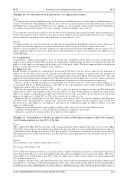Page 627 - SAIT Compendium 2016 Volume2
P. 627
IN 72 Income Tax acT: InTeRPReTaTIon noTes IN 72
Example 12 – No value is placed on the private use of a company motor vehicle
Facts:
Y is employed by Superior Lift Maintenance Pty Ltd (Superior Lift Maintenance) as a lift engineer and lift maintenance expert. Y works 8am – 4pm, Monday to Friday, and is always on call after hours for emergency lift repairs. Superior Lift Maintenance has provided Y with the use of a company car as Y is regularly called out after normal working hours to conduct emergency lift repairs. Y uses the company car when attending to any work call.
Y is allowed to use the motor vehicle to travel between work and home and to park it at home when not using it for work. Y has a private motor vehicle for other private travel and the logbook indicates that Y rarely uses the company motor vehicle for any private travel (other than home to of ce and vice versa).
Result:
Y will not qualify for a nil value of private use under the provision discussed in 4.6.1 because the motor vehicle is not available to or used by employees in general and the motor vehicle is kept at Y’s home outside of ce hours. However, Y may qualify for a nil value of private use under the provision discussed in 4.6.2 because the nature of Y’s duties regularly requires Y to go out to clients after normal work hours. Y’s private use is limited to travelling between work and home.
4.7 Consideration
‘Consideration’, de ned in paragraph 1, does not include any consideration in the form of services rendered by the employee. It would generally include any form of compensation, reimbursement, payment or recompense given by the employee to the employer for being given the right of use of the motor vehicle. The most common form of consideration involves a cash payment by the employee to the employer.
4.8 Employees’ tax
Taxable bene ts are included as ‘remuneration’ in the Fourth Schedule to the Act and are subject to the deduction of employees’ tax. In order to more closely align the travel allowance and company car taxation rules, the de nition of ‘remuneration’ in the Fourth Schedule to the Act was amended with effect from 1 March 2011 to include 80% of the cash equivalent of the taxable bene t as remuneration. This reduced inclusion for the right of use of a motor vehicle (previously 100% was included) takes into account potential adjustments for business travel on assessment for normal tax.
However, in the event that an employer is satis ed that at least 80% of the use of the motor vehicle during a year of assessment will be for business purposes, only 20% of the cash equivalent of the taxable bene t is included as remuneration and is subject to employees’ tax.
This does not mean that only a portion (80% or 20%, as the case may be) is subject to income tax. The full taxable bene t (that is, 100%) is potentially taxable when the employee or of ce holder submits an annual tax return and the employee is unable to claim suf cient reductions for business travel or the cost of the expenses borne. It is only for the purposes of employees’ tax that 80% or 20%, as the case may be, is subject to tax.
Employers that are satis ed that at least 80% of the use of the motor vehicle is for business purposes should include only 20% of the cash equivalent in ‘remuneration’. The word ‘satis ed’ suggests that the employer must actively look into the facts of each employee’s circumstances and objectively weigh up and apply its mind to whether or not the employee would qualify.
Employers can satisfy themselves that employees will use their vehicles for at least 80% business use by –
• regularly reviewing employees’ logbooks which detail business and private travel; and
• taking into consideration changes in the role or function of the employee.
Example 13 – Determination of whether an employer can be satis ed that an employee will use the company car for business purposes at least 80% of the time
Facts:
M is employed by JKL (Pty) Ltd. In terms of M’s employment duties M is required to provide services to all of JKL (Pty) Ltd’s clients who are based in Gauteng. During the previous full year of assessment M maintained a logbook which disclosed the distance travelled as 61 015 km, of which 53 092 km were attributable to business travel. M and the nancial director of JKL (Pty) Ltd agree that M’s functions will remain much the same during the current year of assessment.
Result:
Determination of expected percentage business travel:
53 092 km / 61 015 km = 87%
87% of M’s travel in the previous year of assessment was conducted for business purposes. As the logbook discloses more than four months of accurate data and M’s job pro le and responsibilities are not expected to change, JKL (Pty) Ltd is likely to be satis ed that at least 80% of the use of M’s motor vehicle for the current year of assessment will be for business purposes.
Accordingly, only 20% of the cash equivalent of the value of the taxable bene t must be included in M’s remuneration for employees’ tax purposes. The full cash equivalent of the value of the taxable bene t will need to be included in M’s taxable income when submitting the tax return (subject to qualifying for any of the reductions discussed previously).
saIT comPendIum oF Tax LegIsLaTIon VoLume 2 619


